8.1 Introduction
8.2 Overview of Desalination Technology
8.2.1 Description
8.2.2 Thermal Desalination
8.2.2.1 Multi-Stage Flash Desalination System
8.2.2.2 Multiple Effect Distillation Desalination System
8.2.2.3 Mechanical Vapour Compression Desalination Systems
8.2.2.4 Reverse Osmosis
8.3 History of Desalination in the Pacific
8.3.1 Polynesia
Region | Polynesia | Micronesia | Melanesia |
|---|---|---|---|
First plant | |||
Year of installation | 1965 | 1973 | 1990 |
Location | Hao, Tuamotu Archipelago | Saipan, Northern Mariana Islands | Mamanuca Island, Fiji |
Application | Military support | Tourism | Tourism |
Technology | MSF | MED | RO |
Capacity (m3/d) | 165 | 114 | 50 |
Total plants | |||
Installations—Total | 22 | 34 | 21 |
Applications—Total | Municipal drinking water (11) Industry (9) Tourism (1) | Municipal drinking water (15) Tourism (14) Emergency (3) | Tourism (10) Municipal (8) Industry (3) |
Thermal desalination | |||
Installations | 16 | 2 | 0 |
Total capacity (m3/d) | 8600 | 1314 | - |
Max. Capacity (m3/d) | 1200 | 1200 | - |
Min. Capacity (m3/d) | 121 | 114 | - |
Active Plants | 0 | 0 | - |
RO | |||
Installations | 6 | 32 | 21 |
Total capacity (m3/d) | 5500 | 9970 | 7150 |
Max. capacity (m3/d) | 200 | 1600 | 100 |
Min. capacity (m3/d) | 0.65 | 10 | 2.5 |
Active plants | 6 | 28 | 19 |
Database with license (Global Water Intelligence Desalination Database 2020) | |||
